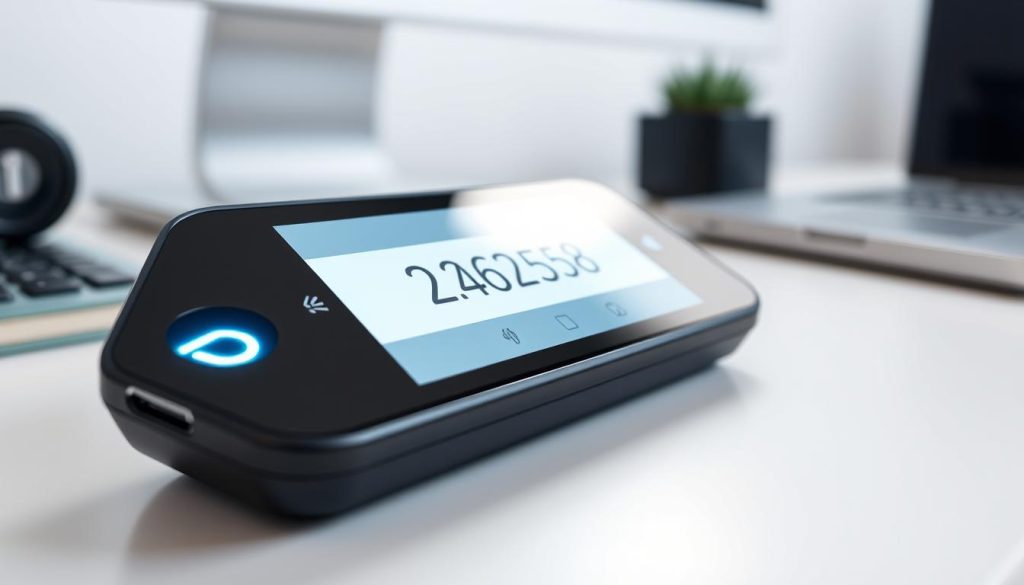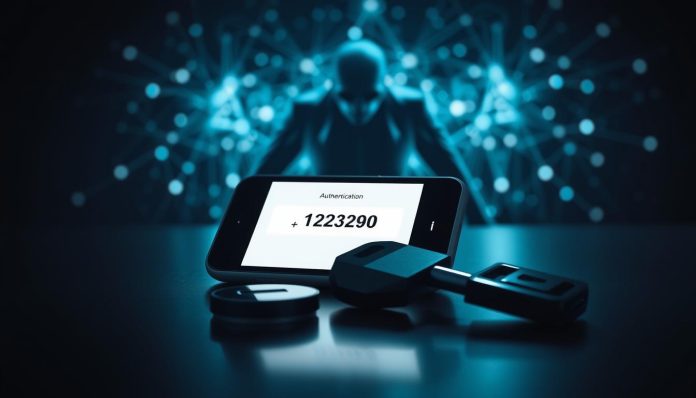Two-factor authentication adds an extra layer beyond passwords, but it is not foolproof. Attackers use phishing kits, browser malware, SIM swapping, and session theft to capture codes and tokens.
This article explains the common ways adversaries break past second factors and shows practical measures that strengthen account security. You will read clear examples of tools like Muraena and NecroBrowser and learn why SMS codes are often weaker than app-based or hardware methods.
We also cover simple habits that reduce risk: avoid public Wi-Fi for logins, lock your SIM with a PIN, and monitor OAuth grants. The goal is to guide you to concrete solutions that protect high-value accounts without guesswork.
Key Takeaways
- Attackers capture codes via phishing kits and browser malware.
- SMS-based methods face higher risk from SIM swapping and interception.
- Use phishing-resistant options like hardware keys and authenticator apps.
- Simple practices—SIM PINs, avoiding public Wi-Fi—cut exposure.
- Monitor OAuth grants and follow a step-by-step plan to harden accounts.
Why Two-Factor Authentication Helps—but Isn’t Bulletproof
A second verification step improves protection, but real-world breaches show it’s not infallible. Two-factor authentication adds a required check beyond a password, so stolen login credentials alone usually won’t grant immediate access to accounts. This raises the effort an attacker must make.
Not all second factors are equal. SMS one-time codes are simple, yet they face risks like SIM swaps and interception. Authenticator apps and hardware security keys offer stronger protection because they are harder to reroute or copy.
Attackers now target people and systems around 2FA. Phishing pages can proxy real logins and capture codes. Malware can steal session cookies after a successful login and bypass the extra check. Sites that skip second-factor checks during password reset create clear policy gaps.
For stronger identity protection, move toward phishing-resistant options such as WebAuthn security keys and passkeys. These methods bind verification to the legitimate domain and cut off many common vectors attackers use to gain access.
- Benefit: Raises the bar beyond passwords for account access.
- Limit: SMS and weak flows remain exploitable.
- Best practice: Favor app-based codes or hardware keys and fix password-reset paths.
How Hackers Bypass Two-Factor Authentication & How to Prevent It
Even with a second step, attackers still find weak links and exploit human trust. Common scams ask victims to reply with a verification code by text or email, or present a realistic login page that relays the code in real time.

Quick reality check
2FA reduces risk, but SMS and recovery flows are frequent targets. Reverse-proxy phishing captures credentials and one-time codes as users enter them. Public WiFi can let an attacker perform a MITM and capture unprotected session data or codes.
Immediate safeguards
- Never share codes. Treat inbound requests for a verification code as suspicious; legitimate services will not ask you to send codes back.
- Verify alerts through a known channel or the official app. Do not follow inbound links or trust caller ID alone.
- Avoid logging in over public WiFi. If necessary, use a trusted VPN and confirm the network name with staff to reduce MITM threats.
- Prefer authenticator apps (TOTP) and hardware keys over SMS. Remove your phone number as a primary recovery method when possible.
- Regularly review recovery settings and connected apps so attackers cannot gain persistent access via social media or OAuth grants.
Common 2FA Bypass Methods in the Wild
Real-world phishing campaigns now pair proxy pages with automation to capture both credentials and one-time codes as users log in. These attacks target the weakest links in a service flow and defeat many common defenses.
Phishing toolkits and reverse proxies:
- Reverse-proxy kits such as Muraena mirror a legitimate website while stealing input in real time.
- Automation frameworks like NecroBrowser then take captured credentials and OTPs to complete session takeovers.
Man-in-the-browser Trojans:
- Trojans inject extra fields on a page and silently harvest what users type, including passwords and codes.
SIM swapping and phone number hijacks:
- SIM swapping moves a victim’s number to an attacker’s SIM, so SMS OTPs and recovery texts route away from the real phone.
Public WiFi MITM and social engineering:
- On insecure networks, a man-in-the-middle can intercept messages and hijack authenticated sessions.
- Scams that ask you to “reply with your verification code” are social engineering designed to finish the attacker’s login—do not respond.
Reduce exposure: Prefer authenticator apps or hardware keys, remove your phone number as a primary recovery option when possible, and treat unexpected verification prompts with suspicion.

Advanced Workarounds Targeting Your Accounts
Modern threats focus on side channels—consent screens, reset tokens, and session cookies—rather than just passwords.
OAuth consent phishing tricks users into granting a malicious app persistent access to data and actions. A realistic “Allow” screen can give an attacker ongoing access even after a password change or when 2FA is enabled.
OAuth consent phishing
Consent phishing targets users already signed in. Once approved, the app keeps an authorized token that can read email, post on social accounts, or export contacts.
Defense: train teams to spot broad scopes and odd domains and revoke suspicious grants fast.
Password reset flow gaps
Some websites allow a reset token to bypass the second check. An attacker who controls a reset email or phone can change an account password and gain access.
Defense: audit reset flows so the second factor is always required during recovery.
Session hijacking
Session theft steals cookies or tokens after a successful login, giving attackers the same authenticated state without credentials.
Defense: secure session handling, short-lived tokens, and rapid revocation reduce the impact of a stolen session.
OTP duplicate-generator attacks
Predictable or weak OTP schemes can be duplicated if an attacker learns the seed and algorithm. This undermines code-based methods.
Defense: rely on vetted authenticator apps and hardware-backed factors rather than custom or weak OTP generators.
“Audit consent scopes, harden reset paths, and monitor session reuse—these steps matter as much as a strong login.”
- Watch newly granted apps for unusual access patterns and revoke overbroad permissions.
- Instrument monitoring for anomalous session reuse across geographies and devices.
- Keep account recovery channels minimal and verified to reduce social-engineered resets.
Proven Ways to Strengthen Authentication Today
Practical choices around devices and networks make authentication far tougher to defeat. Apply a few consistent measures and you cut exposure to common attacks.

Move off SMS codes
Prefer authenticator apps (TOTP) that generate codes on your device. These remove the SMS interception risk and make code theft harder.
Adopt hardware security keys
Use WebAuthn keys or platform passkeys for phishing-resistant verification. Keys bind the check to the legitimate site and cannot be proxied.
Network and SIM measures
Avoid public WiFi for logins. Use a trusted private network or a reputable VPN if needed.
Lock your SIM with a PIN. On iPhone: Settings > Cellular > SIM PIN. On Android: Settings > Security & Privacy > More security settings > SIM card lock.
Review consent screens
Inspect scopes, requesting domains, and grammar. Deny or report apps that ask for excessive access.
| Method | Phishing Resistance | Ease of Use | Best for |
|---|---|---|---|
| Authenticator app (TOTP) | Medium | Easy | Everyday accounts |
| Hardware security key / Passkey | High | Moderate | High-value accounts |
| SMS | Low | Very easy | Legacy recovery only |
Quick checklist: move SMS → TOTP, add keys where possible, use VPN, set SIM PIN, and vet consent screens.
Step-by-Step Hardening Plan for Users and Organizations
First, list your critical accounts and identify which rely on SMS or weak fallbacks. This short audit gives you control over recovery paths and highlights where mfa changes are most urgent.

Replace SMS with stronger factors
Inventory admin and financial accounts first. Move phone-based recovery off SMS and onto TOTP or hardware keys. This reduces risk from sim swapping and phone number hijacks.
Validate password reset flows
Run tabletop and live tests of reset paths. Fix any flow that allows password changes without a second verification step. Confirm sessions and tokens are revoked after resets.
Deploy phishing-resistant MFA
Standardize WebAuthn security keys and passkeys across services. Set policies so new accounts default to these methods and remove legacy SMS where possible.
Monitor OAuth and train users
- Continuously review app grants, revoke risky permissions, and enforce least-privilege scopes.
- Educate users about social engineering in email and messages. Instruct them to never share codes or follow unsolicited login links and to check the website domain before entering passwords.
Quick action: set a SIM PIN, flag unusual carrier changes, and keep an incident playbook ready to lock accounts and invalidate sessions.
Conclusion
Practical defense blends stronger factors and simple habits. Use hardware-backed keys or vetted authenticator apps on each device and protect your phone with a SIM PIN to blunt sim swapping and other social engineering attacks.
Watch recovery paths and app grants closely. Revoke suspicious permissions, end odd sessions, and treat any unexpected verification request as a red flag—confirm via the official service before entering a code or sharing credentials.
Authentication is a baseline; layered security and ongoing user training close the gaps that phishing and session theft exploit. Small steps—better factors, safer networks, and fast revocation—make accounts far harder for a hacker to reach.

